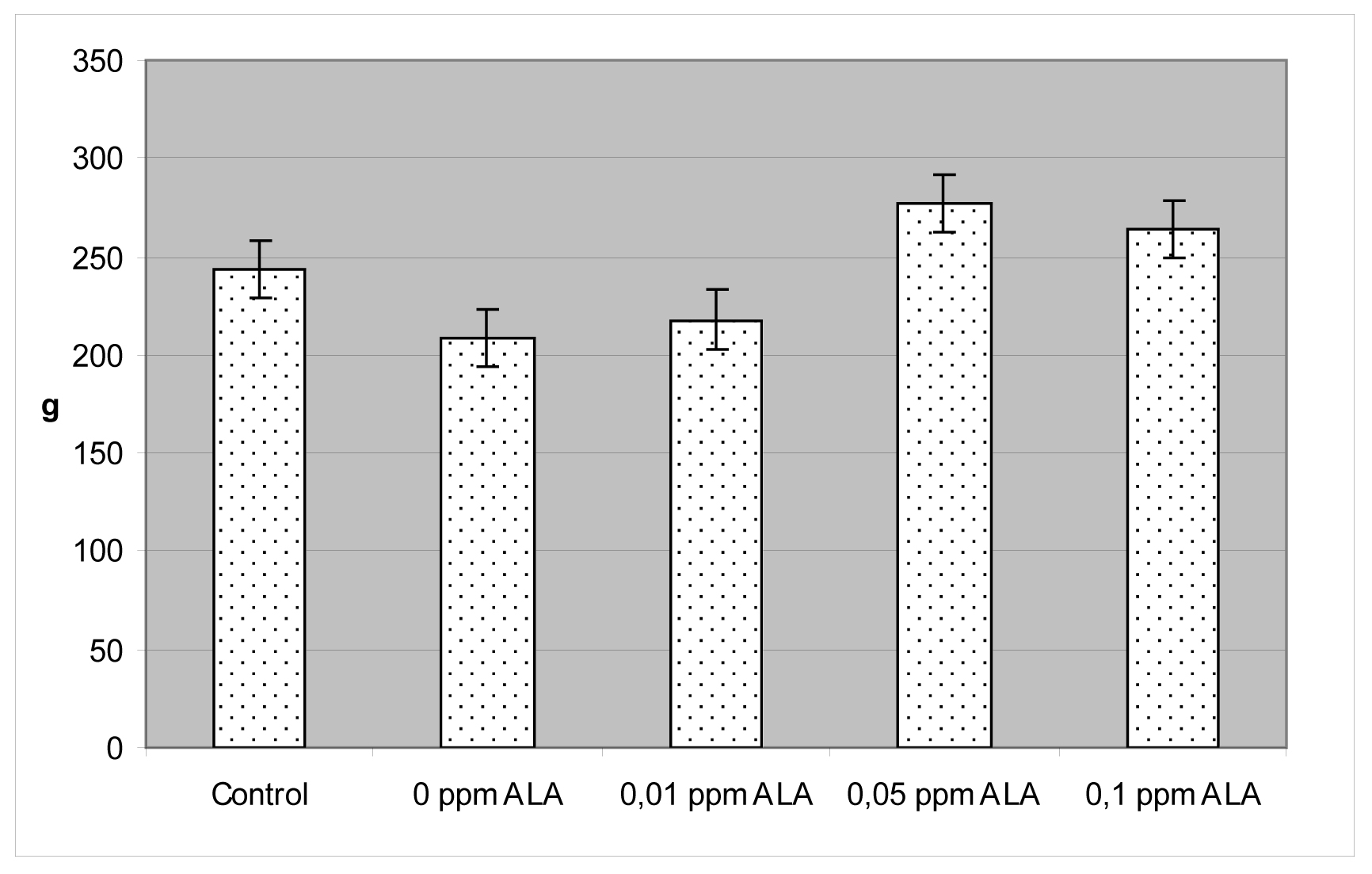The possibility of using 5-aminolevulinic acid in lead phytoextraction process
Abstract
Studies conducted in the greenhouse involving a sunflower (Helianthus annuus L.) grown in medium containing 200 mg Pb ∙ dm-3 which were designed to evaluate the impact of foliar nutrition with 5-aminolevulinic acid (5-ALA) on the chemical composition of sunflower in reference to possible use of this plant in the process of induced phytoextraction. The study revealed from 4.8% to 34.1% increase in aboveground matter of sunflower which was sprayed by 5-ALA solution at concentrations of 0.01-0.1 ppm in comparison with plants grown in a medium containing 200 mg Pb ∙ dm-3 with no 5-ALA spraying. The sunflower leaves sprayed by 5-ALA solution contained from 3.78% to 27.1% more lead in comparison to plants not sprayed by this agent. As well as remarkable decrease in lead content from 17.4 to 33.4% was recorded in the roots of sunflower sprayed by 5-ALA solution. The lead content in plant shoots was independent from foliar application of 5-aminolevulinic acid.
References
den Hertog C. 2008. Effect of Pentakeep fertilizers in greenhouse production. Pentakeep International Scientific Workshop 2008 in Italy (8-9 December 2008, Milan, Italy).
Gadapati W.R. Macfie S.M. 2006. Phytochelatins are only partially correlated with Cd-stress in two species of Brassica. Plant Sci. 170: 471–480.
Ghosh M., Singh S.P. 2005. A review of phytoremediation of heavy metals and utilization of its byproducts. Appl. Ecol. Env. Res. 3 (1): 1–18.
Gruca-Krolikowska S., Wacławek W. 2006. Metale w środowisku. Cz. II. Wpływ metali ciężkich na rośliny. Chem. Dydakt. Ekol. Metrol. 11 (1-2): 41–54.
Jarosz Z. 2012. Wpływ nawozu Pentakeep® V na plonowanie oraz zawartość wybranych makro- i mikroelementów w sałacie. Annales UMCE, EEE XXII (1): 1–8.
Kucharski R., Sas-Nowosielska A, Małkowski E. 1998. Treatability study report. Integrated approach to the remediation of heavy metal-contaminated land. U.S. Department Of Energy.
Kurtyka R., Małkowski E., Kita A., Karcz W. 2008. Effect of calcium and cadmium on growth and accumulation of cadmium, calcium, potassium, and sodium in maize seedlings. Polish J. Environ. Study. 17: 51–56.
Luo C.L., Shen Z.G., Li X.D. 2005. Enhanced phytoextraction of Cu, Pb, Zn and Cd with EDTA and EDDS. Chemosphere 59: 1–11.
Małkowski E. 2011. Modyfikacja procesu transpiracji a efektywność indukowanej fitoekstrakcji ołowiu i kadmu w wybranych gatunkach roślin. Wyd. Uniwersytetu Śląskiego, Katowice.
Memon S.A., Hou X., Wang L., Li Y., 2009. Promotive effect of 5-aminolevulinic acid on chlorophyll, antioxidative enzymes and photosynthesis of Pakchoi (Brassica campestris ssp. chinensis var. communis Tsen et Lee). Acta Physiol. Plant. 31: 51–57.
Ostrowska A., Gawliński S., Szczubiałka Z. 1991. Metody analizy i oceny gleb i roślin. Instytut Ochrony Środowiska, Warszawa.
Rosada J. 2007. Ekologiczne aspekty wykorzystania obszarów objętych oddziaływaniem emisji hut miedzi do upraw rolniczych. Prog. Plant Prot. 47(1): 119–127.
Salt D.E., Smith R.D., Raskin I. 1998. Phytoremediation. Annu. Rev. Plant Physiol., Plant Mol. Biol. 49: 643–668.
Smoleń S., Sady W. 2010. Effect of plant biostymulation with Pentakeep V fertilizer and nitrogen fertilization on the content of macro- and micronutrients in spinach. J. Elementol. 15 (2): 343–353.
Tanaka T., Iwai K., Watanabe K., Hotta Z. 2005. Development of 5-aminolevulinic acid for agriculture uses. Regul. Plant Growth Devel. 40 (1): 22–29.
Tyksiński W. 2002. Mechanizmy tolerancji na zwiększone zawartości metali ciężkich w glebach i podłożach. Rocz. Akad. Roln. Poznań, Ogrodnictwo CCCXLI: 209–214.
Żurek G., Majtkowski W. 2009. Rośliny alternatywne w fitoekstrakcji metali ciężkich z terenów skażonych. Problemy Inżynierii Rolniczej 3: 83–89.


This work is licensed under a Creative Commons Attribution-NonCommercial-NoDerivatives 4.0 International License.
The journal is licensed by Creative Commons under BY-NC-ND license. You are welcome and free to share (copy and redistribute the material in any medium or format) all the published materials. You may not use the material for commercial purposes. You must give appropriate credit to all published materials.
The journal allow the author(s) to hold the copyrights and to retain publishing rights without any restrictions. This is also indicated at the bottom of each article.





